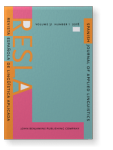Vol. 31:1 (2018) ► pp.124–158
Vol. 31:1 (2018) ► pp.124–158
The use of L3 English articles by Basque-Spanish bilinguals
In this paper we compare the data from a group of L1 Basque-Spanish bilingual learners of L3 English with a matching group of L1 Spanish learners of L2 English. The results show that the bilinguals omit articles and overuse ‘the’ more than the L1 Spanish group. The pattern of omissions by the bilinguals shows that one subgroup omitted heavily while the other produced only sporadic omissions. With respect to overuse, the bilinguals consistently overused ‘the’ in indefinite contexts, while ‘a’ overuse was practically absent. The results from the bilingual group pattern with findings from [−article] L1 learners, a pattern which would fit with an analysis of Basque as a language without articles (Manterola 2012, 2015). The finding that the bilinguals do not transfer article semantics from Spanish, unlike the learners in the L1 Spanish group, suggests that recency may be determining the language of transfer in the bilingual learners tested.
Article outline
- 1.Introduction
- 2.The acquisition of articles in non-native English
- 3.The article system in Spanish and Basque
- 4.Research questions
- 5.Method
- 5.1Participants
- 5.2Materials and procedure
- 5.3Data coding
- 6.Results
- 6.1Accuracy in the use of definites and indefinites
- 6.2Error type distribution in definite and indefinite contexts
- 7.Discussion and conclusion
- Notes
-
References
